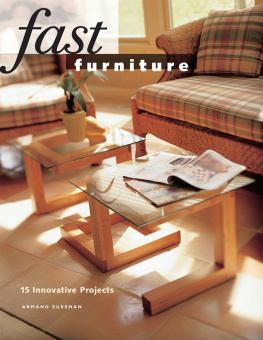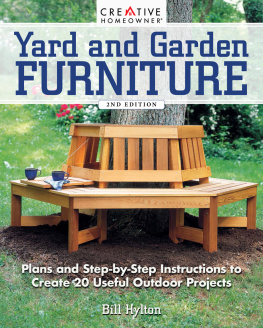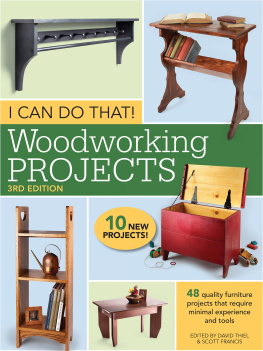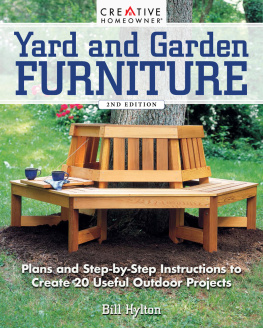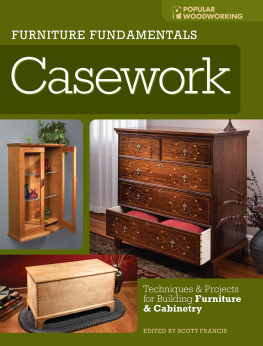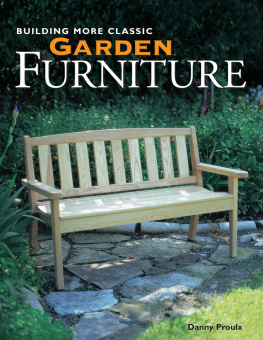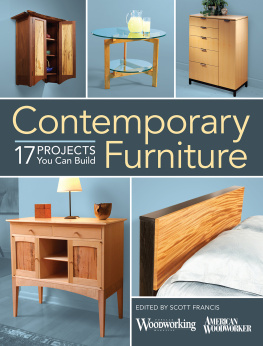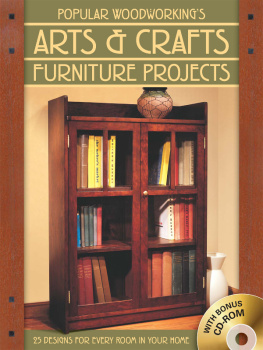fast furniture
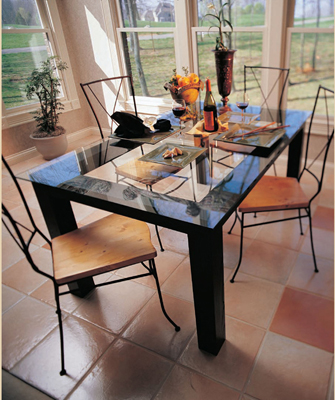
ARMAND SUSSMAN

Fast Furniture. Copyright 2000 by Armand Sussman. Manufactured in China. All rights reserved. No part of this book may be reproduced in any form or by any electronic or mechanical means including information storage and retrieval systems without permission in writing from the publisher, except by a reviewer, who may quote brief passages in a review. Published by Popular Woodworking Books, an imprint of F&W Publications, Inc., 1507 Dana Avenue, Cincinnati, Ohio, 45207. First edition.
Visit our Web site at www.popularwoodworking.com for information on more resources for woodworkers.
Other fine Popular Woodworking Books are available from your local bookstore or direct from the publisher.
04 03 02 01 00 5 4 3 2 1
Library of Congress Cataloging-in-Publication Data
Sussman, Armand 1918
Fast Furniture/by Armand Sussman
p. cm.
ISBN 1-55870-543-0 (paperback)
eISBN-13: 978-1-4403-1617-3
1. Tables. 2. Furniture making. I. Title.
TT197.5.T3 S87 2000
684.1'3 dc21 00-042783
Projects constructed by Jim Stack
Edited by Michael Berger, Jennifer Churchill
Designed by Brian Roeth
Production coordinated by John Peavler
Page layout by Ben Rucker
Finished projects photographed by Al Parrish
Step-by-step photography by Jim Stack
Location for photography of finished projects provided by Continental Web Press. All projects in this book were constructed in the Popular Woodworking Books woodshop.
METRIC CONVERSION CHART
to convert | to | multiply by |
Inches | Centimeters | 2.54 |
Centimeters | Inches | 0.4 |
Feet | Centimeters | 30.5 |
Centimeters | Feet | 0.03 |
Yards | Meters | 0.9 |
Meters | Yards | 1.1 |
Sq. Inches | Sq. Centimeters | 6.45 |
Sq. Centimeters | Sq. Inches | 0.16 |
Sq. Feet | Sq. Meters | 0.09 |
Sq. Meters | Sq. Feet | 10.8 |
Sq. Yards | Sq. Meters | 0.8 |
Sq. Meters | Sq. Yards | 1.2 |
Pounds | Kilograms | 0.45 |
Kilograms | Pounds | 2.2 |
Ounces | Grams | 28.4 |
Grams | Ounces | 0.04 |
READ THIS IMPORTANT SAFETY NOTICE
To prevent accidents, keep safety in mind while you work. Use the safety guards installed on power equipment; they are for your protection. When working on power equipment, keep fingers away from saw blades, wear safety goggles to prevent injuries from flying wood chips and sawdust, wear headphones to protect your hearing, and consider installing a dust vacuum to reduce the amount of airborne sawdust in your woodshop. Don't wear loose clothing, such as neckties or shirts with loose sleeves, or jewelry, such as rings, necklaces or bracelets, when working on power equipment. Tie back long hair to prevent it from getting caught in your equipment. People who are sensitive to certain chemicals should check the chemical content of any product before using it. The authors and editors who compiled this book have tried to make the contents as accurate and correct as possible. Plans, illustrations, photographs and text have been carefully checked. All instructions, plans and projects should be carefully read, studied and understood before beginning construction. Due to the variability of local conditions, construction materials, skill levels, etc., neither the author nor Popular Woodworking Books assumes any responsibility for any accidents, injuries, damages or other losses incurred resulting from the material presented in this book.
About the author
Back in the 1920s and 1930s, when make do was a way of life, handsawing and machine sewing were the two hobbies of Armand Sussman. In his pre-teen and teen years, he designed and made his own toys and games, did home repairs and remodeling, and was great at chess and long-distance swimming.
Armand's college education (he was studying to become a math and science teacher) was cut short when he was drafted shortly before the attack on Pearl Harbor. While stuck in the infantry, guarding the Panama Canal, he volunteered to join the Army Air Corps in order to get into action. Armand became an officer and earned his wings, enabling him to fly as the navigator on the crew of a Flying Fortress B-17 bomber. He navigated over the North Atlantic using only the stars to guide him. He arrived in England to join the 8th Air Force after more than a year of navigation school and crew training.
Two months before D-Day in 1944, while he and his crew were on one of their many bombing missions over Germany, his plane was destroyed by flak and fighter planes. All 10 crewmen, some wounded, bailed out and all were captured as P.O.W.s for 13 months.
After WWII, from 19461952, Armand managed an 80-employee sewing plant. Then he put his woodworking hobby to work, selling nationally by mail-order the home furnishings he designed and made.
In the mid-1950s, Armand was a designer for a corrugated container manufacturer. In 1957, he opened a clothing store from which he retired in 1992 at age 74. However, he continued designing, making and writing about wooden home furnishings. He is still expanding on his concept of woodworking using only sticks and glue to create a variety of unique home furnishings.
Dedication
To my neighbors, who never complain about my favorite sound: the noise that my table saw makes at some crazy-hour times. I am also grateful to the kids playing in the back alley who offset my table-saw noise with other favorite sounds of mine: their laughter, yelling, squealing, and some screaming, during the no-school summer months.
My most heartfelt dedication goes to the guys and gals for whom I have written this book.
introduction
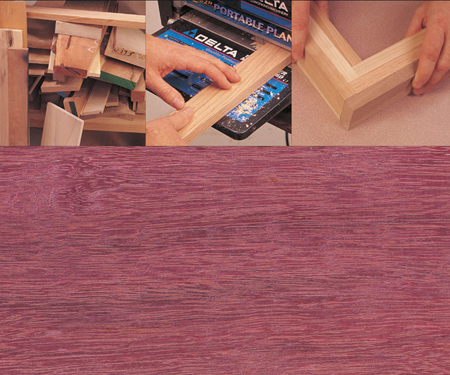
F ast furniture is made from materials you're likely to have in your woodworking shop. As a youngster, long before the days of conservation awareness, I was F programmed by the deprivation of the 1930s not to throw away a piece of wood even a few inches long. I became a saver of maybes (maybe I'll need it). Years later I realized the pile of maybes in my woodworking shop had grown too large. One day, as I sat staring at the pile of scrap lumber, I thought, why not make furniture from sticks? It would be simple, inexpensive, sturdy and even attractive. My pulse quickened with the possibilities. It would be a total departure from most woodworking methods and easy to be creative. The only materials needed would be glue and wood sticks.
In these projects, we have just flat sticks all the same thickness and width but with different lengths cut with squared ends; no angles, curves or grooves. So how can you make a useful furnishing or accessory from just plain sticks? Every project has detailed instructions on how to build a piece of furniture made just from sticks and glue that will intrigue your family and friends. You can also tailor the projects to the sizes you might need. Upscale a table for four to a table for eight, or a snapshot-size picture frame to a 6 10 mural frame.

